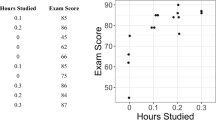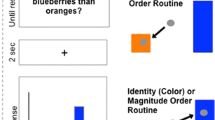Abstract
Researchers in all areas of science recognize the value of graphical displays and research on graphs has focused on determining which graphical elements enhance readability. To date, no research has examined the physiological processing of graphs. The purpose of this project was to examine the event-related potentials (ERPs) associated with the processing of bivariate scatterplots. Participants viewed scatterplots depicting different linear relationships (positive and negative; strong and weak) and their ERPs were analyzed. Results indicate interesting differences in how scatterplots are processed. Overall, there was differential processing in posterior, medial, and anterior brain sites. Sites on the left and right sides of the brain showed different patterns of activity in response to the scatterplots. In addition, results suggest that different relationships are processed differently in the brain (confirming previous research that has suggested that the perception of covariation is dependent upon the type of relationship depicted on a scatterplot).
Support for this project was provided by the New Brunswick Innovation Fund.
Preview
Unable to display preview. Download preview PDF.
Similar content being viewed by others
References
Adams, A.: Is a Graph Different than a Picture? An Electrophysiological Examination of Graph Perception. Unpublished honours thesis, University of New Brunswick (unpublished manuscript, 2005)
Beniger, J.R., Robyn, D.: Quantitative Graphics in Statistics: A Brief History. The American Statistician 32, 1–11 (1978)
Best, L.A., Adams, A., Jones, S., Hickman, E., Hunter, A., LeBlanc, A., Stewart, B., Woodland, J.: Is A Picture Worth 1000 Words: An Electrophysiological Examination of Graph Perception. In: The CPA annual meeting (2006)
Beyth-Marom, R.: Perception of correlation reexamined. Memory and Cognition 10, 511–519 (1982)
Cleveland, W.S., McGill, R.: Graphical perception and graphical methods for analyzing scientific data. Science 229, 828–833 (1982)
Erlick, D.E., Mills, R.: Perceptual quantification of conditional dependency. Journal of Experimental Psychology 73, 9–14 (1967)
Funkhouser, H.G.: Historical development of the graphical representation of statistical data. Osiris 3, 269–404 (1937)
Holland, J.L.: Dual-coding Hypothesis and the Perception of Graphical Displays: Is a Picture Worth a Thousand Words? Unpublished honours thesis, University of New Brunswick, Saint John (2004)
Jausovec, N.: Differences in EEG alpha activity related to giftedness. Intelligence 23, 159–173 (1996)
Jenkins, H.M., Ward, W.C.: Judgment of contingency between responses and outcomes. APA, Washington (1965)
Kareev, Y.: Positive Bias in the Perception of Covariation. Psychological Review 102, 490–502 (1995)
Kolb, B., Whishaw, I.Q.: Fundamentals of Human Neuropsychology, 5th edn. W.H. Freeman, New York (2003)
Lane, D.M., Anderson, C.A., Kellam, K.L.: Judging the relatedness of variables: The psychophysics of covariation detection. Journal of Experimental Psychology: Human Perception and Performance 11, 640–649 (1985)
Luck, S.J.: An introduction to the event-related potential technique. MIT Press, Cambridge (2005)
Mayer, R.E., Anderson, R.B.: Animations need narrations: An experimental test of a dual-coding hypothesis. Journal of Educational Psychology 83, 484–490 (1991)
Mayer, R.E., Gallini, J.K.: When is an illustration worth ten thousand words? Journal of Educational Psychology 88, 715–726 (1990)
Mayer, R.E., Moreno, R.: Aids to computer-based multimedia learning. Learning and Instruction 12, 107–119 (2002)
Mayer, R.E.: Models for Understanding. Review of Educational Research 59, 43–64 (1989)
Mazoyer, B., Tzourio-Mazoyer, N., Mazard, A., Denis, M., Mellet, E.: Neural bases of image and language interactions. International Journal of Psychology 37, 204–208 (2002)
Moreno, R., Mayer, R.E.: Personalized messages that promote science learning in virtual environments. Journal of Educational Psychology 96, 165–173 (1998)
Paivio, A.: Imagery and verbal processes. Holt Rinehart, New York (1971)
Paivio, A.: Mental representations: A dual-coding approach. Oxford University Press, New York (1986)
Petre, G., Green, T.R.G.: Learning to read graphics: Some evidence that ‘seeing’ an information display is an acquired skill. Journal of Visual Languages and Computing 4, 55–70 (1993)
Pinker, S.: A theory of graph comprehension. In: Friedle, R. (ed.) Artificial intelligence and the future of testing. Erlbaum, Hillsdale (1990)
Smith, L.D., Best, L.A., Cylke, V.A., Stubbs, D.A.: Psychology without p values: Data analysis at the turn of the century. American Psychologist 55, 260–263 (2000)
Strahan, R.F., Hansen, C.J.: Underestimating correlation from scatterplots. Applied Psychological Measurement 2, 543–550 (1978)
Tilling, L.: Early experimental graphs. The British Journal for the History of Science 8, 193–213 (1975)
Vekiri, I.: What is the value of graphical displays in learning? Educational Psychology Review 14, 261–311 (2002)
Wainer, H.: Visual revelations. In: Graphical tales of fate and deception from Napoleon Bonaparte to Ross Perot, Copernicus, New York (1997)
Wilkinson, L.: Statistical methods in psychology journals: Guidelines and explanations. American Psychologist 54, 594–604 (1999)
Author information
Authors and Affiliations
Editor information
Editors and Affiliations
Rights and permissions
Copyright information
© 2006 Springer-Verlag Berlin Heidelberg
About this paper
Cite this paper
Best, L.A., Hunter, A.C., Stewart, B.M. (2006). Perceiving Relationships: A Physiological Examination of the Perception of Scatterplots. In: Barker-Plummer, D., Cox, R., Swoboda, N. (eds) Diagrammatic Representation and Inference. Diagrams 2006. Lecture Notes in Computer Science(), vol 4045. Springer, Berlin, Heidelberg. https://doi.org/10.1007/11783183_33
Download citation
DOI: https://doi.org/10.1007/11783183_33
Publisher Name: Springer, Berlin, Heidelberg
Print ISBN: 978-3-540-35623-3
Online ISBN: 978-3-540-35624-0
eBook Packages: Computer ScienceComputer Science (R0)




